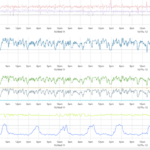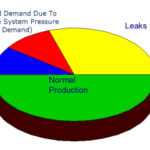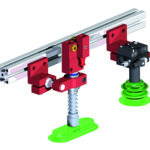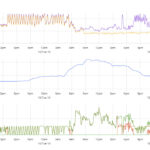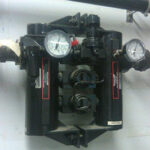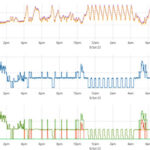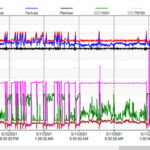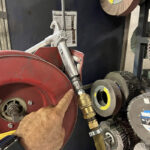A compressed air auditor was hired to have a close look at the main compressed air system at a farm implement manufacturing plant. Data collection instruments were placed on the system to measure pressure, flow, and power. The auditor also placed a dewpoint meter at the discharge of the compressor room, after the main air […]
Compressed air fail: Here’s a record you don’t want to break
One important item discussed in Compressed Air Challenge’s Fundamentals of Compressed Air Systems seminars is leakage. The most common waste category is compressed air. When studies are done looking at leakage rates compared to the total amount of compressed air produced, on average somewhere between 20% and 30% is found at manufacturing facilities (Fig. 1). […]
Material handling system features new vacuum technology
A new tooling system allows auto manufacturers to construct vacuum-end effector tools with minimal design time — to meet their exact needs for critical applications, such as sheet metal stamping, die-casting, injection molding, thermoforming, and glass handling. Made of hard-coat anodized aluminium, the Piab Modular Automation Tooling (PMAT) is lightweight and easy to assemble on-site […]
How can you reduce air leaks without turning a wrench?
What if you could reduce all your leaks without turning a wrench? Well, it is possible with good pressure control. And sometimes it is as easy as turning a knob. The principle is shown in the following orifice chart, Fig. 1. As the pressure to a leak reduces by 1 psi, the flow consumed by […]
Compressed air fail: Dead PFCs
One of many energy conservation measures available to industrial users is the use of pressure/flow control regulators. These are installed in systems to reduce the plant pressure while leaving the air compressors to operate within a wide pressure band, making them more efficient. A compressed air pressure/flow controller is a device used to regulate and […]
Compressed air fail: Pony compressor
A large automotive service shop had two 100-hp compressors, one being a VSD, both available to supply the compressed air they needed for painting and body assembly of large vehicles. The load was full of peaks, and the maintenance staff needed up to 400 cfm to provide flow to paint booths and breathing air hoods […]
Piab strengthens its grip on palletizing with LBG-50
An unavoidable challenge when defining a new bag gripping system in a palletizing line is to get the exact measurements to align with the conveyor rollers for a smooth lifting and releasing process. This demands time-consuming analysis and design and, later, even more time for adaptation and adjustments. Furthermore, additional solutions may have to be […]
Compressed air fail: Penny pinching
A farm implement manufacturer expanded its facility about 15 years ago, and personnel decided they wanted a premium compressed air system. They purchased three very efficient two-stage premium compressors, one being a VSD, and connected the equipment with large piping to reduce pressure loss. Filters were mist-eliminator style to reduce pressure loss. Air dryers were […]
Compressed air fail: Poor sealing methods
If you have ever done leakage detection with an ultrasonic leak detector you will get to know the common leak locations. If you have no detector, there is no excuse these days, excellent equipment is available for you to purchase at a reasonable price, go get it! A common sight — or rather sound — […]
Busch Vacuum Solutions introduces new R5 RA
The new rotary vane vacuum pump R5 RA 0520 A from Busch increases energy savings by up to 25%. It features a compact and hygienic design, reduced heat emissions, and enables faster and easier maintenance. The optional Ecotorque variable speed drive provides up to 50% additional energy savings and a 20% increase in pumping speed. […]

